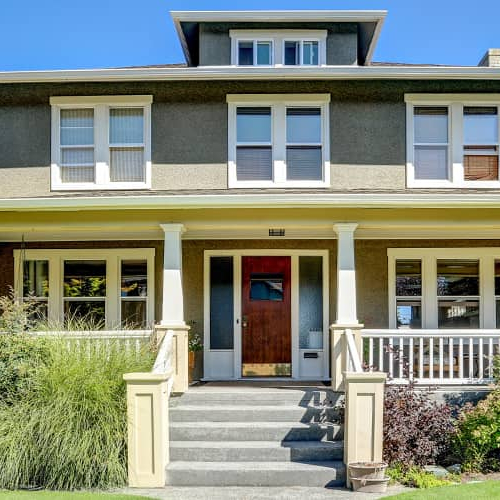How much house can I afford on $120K?
Dec 12, 2024
•7-minute read
With news reports of home prices seemingly always on the rise and interest rates sticking stubbornly at elevated levels, it can be easy to see the challenge to buying a house in the current market. But you’ve landed here because you’re asking yourself, “How much house can I afford on a $120K salary?” We have a stat that should be encouraging:
According to data for 2023 from the U.S. Census Bureau, the median household income is $80,610. Everyone has a different lifestyle, and you could always use more money. But if you’re making $120,000, you can feel pretty good about your situation and the resources you might have to buy a house with the right budgeting practices.
The budget range
Speaking hypothetically, your budget range for a home on a $120,000 salary is $285,088 – $440,771. This is based on buying in Atlanta with $25,000 saved and $1,225 in monthly debt (national average) with a credit score of at least 720. The interest rate is 7.125%. Assumed taxes and a $67 monthly homeowners insurance premium were included.
Every situation is different. So much goes into determining what you can afford that the only right answer can be provided by a Home Loan Expert when you apply and a lender goes deep on your financial situation. Without doing that, the answer is always, “It depends.” This is both true and deeply unsatisfying.
We’ll get more into this later, but for now, know that any decent mortgage calculator is going to give highly variable results based on the following factors:
- The area you’re looking to buy
- Your income
- Amount of cash on hand
- Self-assessed credit score
You can put in your own numbers with our Home Affordability Calculator to get an idea of how much buying power you have prior to diving into the mortgage process.
How to estimate how much house you can afford on a $120K salary
Every lender has slightly different standards when it comes to judging how much you can afford, but there are some general rules you can rely on. We’ll go over these and then discuss what it looks like if you tweak some of the variables.
What percentage of my income should I put toward a mortgage?
One of the most common guideposts is the 28/36 rule. The idea here is that you spend no more than 28% of your pretax income on your monthly mortgage payment and no more than 36% of your income on your overall debts.
It’s important to remember that your house payment is more than the cost of the loan itself. It also includes taxes, mortgage insurance and homeowners insurance.
Once you do this calculation, you can then add back in the rest of your debts to come up with your overall debt-to-income ratio. Here are the formulas for the ratios, starting with the housing expense ratio:
Principal + Interest + Taxes + Homeowners insurance
___________________________________________________ × 100
Pretax monthly income
Mortgage insurance and homeowners association fees may be included in the above, but not everyone has them. There is no mortgage insurance at all on conventional loans for single-unit primary residences if you make a 20% down payment.
Here’s the formula for DTI:
Total debts
_________________________ ×100
Pretax monthly income
Your total debts include not just your mortgage payment, but also things like student loans and personal loans, car payments and the minimum amount due on credit cards.
The 28/36 rule isn’t the only one that’s helpful to know when it comes to the percentage of income toward a mortgage. For FHA and VA loans, it’s quite common for the standard to be that you spend no more than 38% of your budget on housing and 45% on total debts. For conventional loans, you usually want to keep your DTI under 43%.
Mortgage breakdown on a $120K salary
So we’ve gone over what a mortgage payment looks like in one very specific situation to give you a general idea, but what happens if we play with the numbers a bit?
We’ve kept the interest rate the same at 7.125% because it may go up or down, but you don’t control that. You can control the debt you have and your down payment. Let’s look at several scenarios:
| Existing debts | Cash on hand | Mort affordable | Stretching it |
|---|---|---|---|
| $2,000 | $15,000 | $190,512 | $346,195 |
| $0 | $15,000 | $410,806 | $582,094 |
| $3,000 | $40,000 | $106,575 | $255,977 |
Factors that impact how much house you can afford
Beyond your salary, several other factors play a big role in what you can afford. Let’s take a look.
Credit score
Your credit score is a three-digit number between 300 – 850. Higher is better. You need a certain credit score to qualify for various home loans. As an example, conventional loans generally require a 620 credit score.
You may not realize how much your credit score impacts what you can afford. Along with your down payment, it is a key factor in your interest rate. For a higher score, prioritize making payments by their due dates, limiting the amount of credit you apply for to only what you need and maintaining credit card balances under 30% of your limits.
Down payment
Your down payment is an upfront amount paid when you close your loan. This gives lenders some assurance that you have something invested in the home prior to funding your mortgage.
For a single-unit primary residence, you’re looking generally at 3% – 5% down depending on the loan type you qualify for. However, as noted above, bigger down payments can mean better interest rates and the chance to avoid mortgage insurance. It’s also a great way to lower your mortgage payment based on the smaller balance.
Closing costs
Closing costs account for all the fees associated with buying a home. Some are paid to the lender, like an origination or processing fee, while others cover title work and insurance. Then there are fees paid to the county for deed recording and others for flood certification.
Closing costs are negotiable between you and the seller. For example, you might discuss who pays the real estate agents. Sometimes, the lender will give you a credit toward closing costs in exchange for you taking a slightly higher interest rate. Closing costs are generally in the range of 3% – 6% of the purchase price.
Debt-to-income ratio (DTI)
Your DTI is the percentage of your income that goes toward paying debts, including your mortgage, each month. In general to qualify, you want your overall debts to be no higher than 43%, but every situation is different. For FHA or VA loans, you can qualify with a slightly higher DTI if your FICO® Score is above 620 when you apply.
Remember, sometimes your housing expense ratio is considered and sometimes it’s just your overall DTI. A Home Loan Expert will be able to walk you through this. If you’re looking to lower your DTI to qualify, the best thing to do is to pay off the balances with the biggest monthly payments first to leave more room in your budget.
Current interest rates
This one may fall under the category of the obvious, but it’s worth mentioning. One of the biggest impacts on buying power is the interest rate that you get. If rates are lower, it means being approved for a higher amount relative to when rates are elevated.
Mortgage terms
The term of your mortgage is how long you have the loan if you make only the scheduled payments by their due date each month. Shorter terms mean lower interest rates and paying less interest overall, but taking a longer-term loan can increase your affordability because the monthly payment will be smaller.
Location and amenities
Location can play a big role in the cost of a home. Homes in Boston are typically more expensive than a home in a less densely populated area, for example.
But beyond that, there can be wide variation from city to city and even neighborhood to neighborhood based on things like desirable schools and hospitals, distance to entertainment and restaurants and more.
Maintenance and repairs
Even the best cared-for home eventually needs maintenance. Roofs and appliances need replacement at some point.
Depending on the condition of the home and its age, experts recommend that you set aside 1% – 3% of the purchase price of the home each year for maintenance. Some years you may not touch this money at all, and others you’ll be glad you had it.
Homes have to be move-in ready in order to be eligible for a mortgage. If there is a safety issue, it has to be repaired before you can move forward. You can negotiate with the seller as to who handles this.
If the issue is big enough and the seller doesn’t want to fix it, you may be able to back out of the deal and get your deposit returned if you have an inspection contingency.
Taxes and insurance
Real estate taxes are based on the value of your property and pay for city services and the public schools in your area. Homeowners insurance covers you in the event of property damage, theft and liability if someone injures themselves on your property. Mortgage lenders require you to have homeowners coverage to rebuild if necessary.
Most people have these included in their mortgage payment as part of an escrow account so that they are split into monthly increments rather than one or two big bills each year. But even if you don’t have an escrow account, it’s important to account for these expenses in your budget.
The bottom line: Affording a house with $120K a year
If you make $120,000 a year, affording a house is very possible on your salary as long as you know what to prepare for and you budget properly. In addition to salary, it’s important to consider your savings and the other financial goals that you have. The right time to buy isn’t based on a number or an interest rate. It’s when you’re ready.
If you’d like to get started, you can move forward with the mortgage application process.
Kevin Graham
Kevin Graham is a Senior Writer for Rocket. He specializes in mortgage qualification, economics and personal finance topics. Kevin has passed the MLO SAFE exam given to mortgage bankers and takes continuing education courses. As someone with cerebral palsy spastic quadriplegia that requires the use of a wheelchair, he also takes on articles around modifying your home for physical challenges and smart home tech. He has a BA in Journalism from Oakland University.
Related resources

10-minute read
How much house can you afford?
Ever asked, “How much house can I afford?” Determine how much you can spend on a mortgage with help from the Rocket Mortgage home affordability calc...
Read more

9-minute read
How to get a mortgage preapproval
Mortgage preapproval is an important step in your home-buying journey that helps you understand your borrowing ability. Find out what the process involves.
Read more

7-minute read
The costs of buying a house that first-time home buyers should prepare for
There are many ongoing and up-front costs associated wit...
Read more